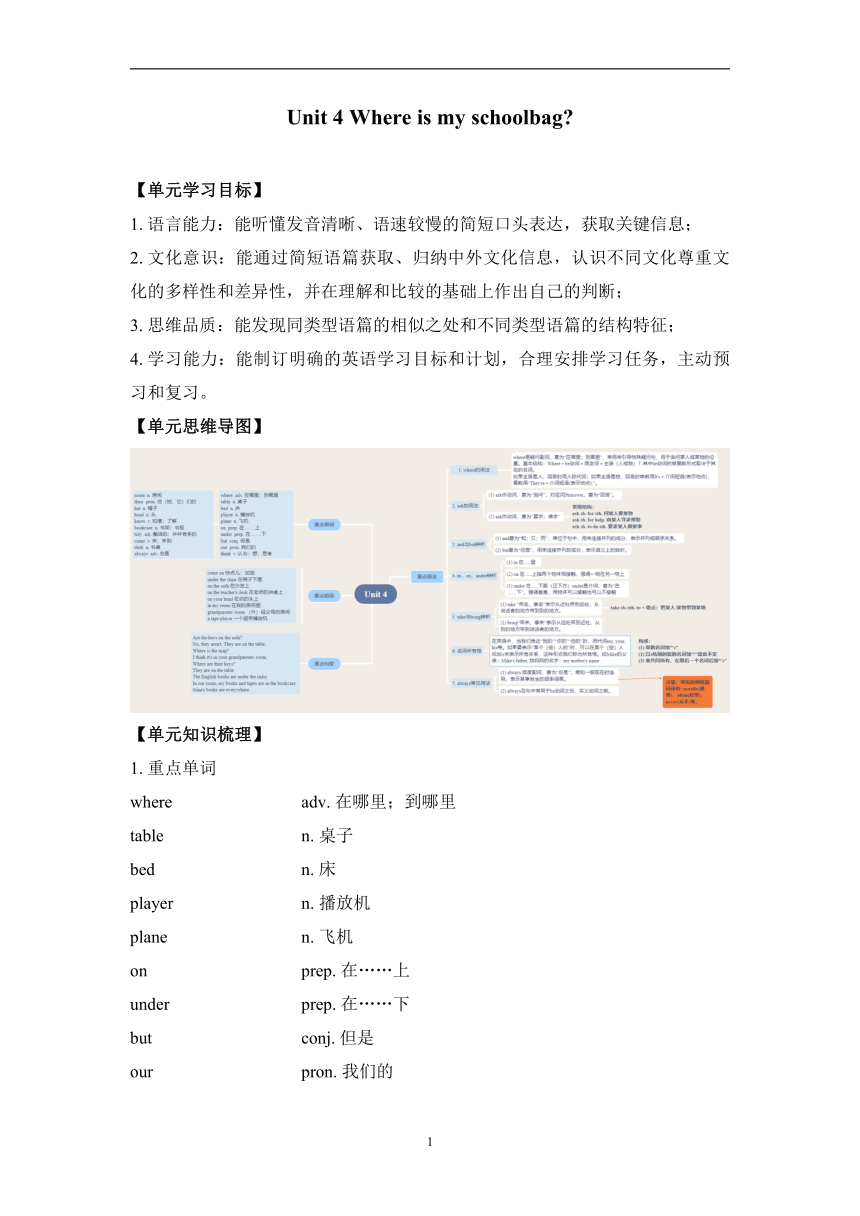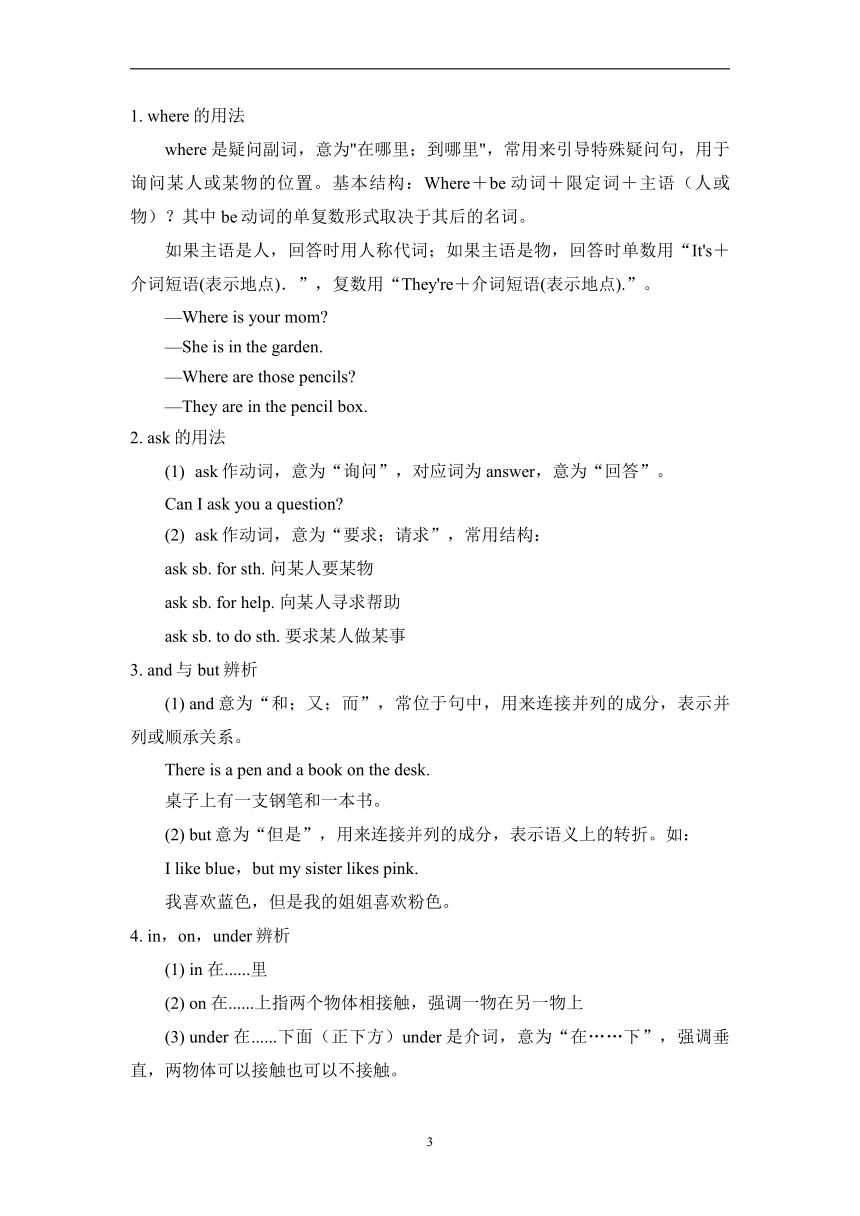Unit 4 Where is my schoolbag?单元知识清单学案
文档属性
| 名称 | Unit 4 Where is my schoolbag?单元知识清单学案 |  | |
| 格式 | docx | ||
| 文件大小 | 183.4KB | ||
| 资源类型 | 教案 | ||
| 版本资源 | 人教新目标(Go for it)版 | ||
| 科目 | 英语 | ||
| 更新时间 | 2023-10-28 14:43:36 | ||
图片预览



文档简介
Unit 4 Where is my schoolbag
【单元学习目标】
语言能力:能听懂发音清晰、语速较慢的简短口头表达,获取关键信息;
文化意识:能通过简短语篇获取、归纳中外文化信息,认识不同文化尊重文化的多样性和差异性,并在理解和比较的基础上作出自己的判断;
思维品质:能发现同类型语篇的相似之处和不同类型语篇的结构特征;
学习能力:能制订明确的英语学习目标和计划,合理安排学习任务,主动预习和复习。
【单元思维导图】
【单元知识梳理】
1. 重点单词
where adv. 在哪里;到哪里
table n. 桌子
bed n. 床
player n. 播放机
plane n. 飞机
on prep. 在……上
under prep. 在……下
but conj. 但是
our pron. 我们的
think v. 认为;想;思考
room n. 房间
their pron. 他(她、它)们的
hat n. 帽子
head n. 头
know v. 知道;了解
bookcase n. 书架;书柜
tidy adj. 整洁的;井井有条的
come v. 来;来到
desk n. 书桌
always adv. 总是
2. 重点短语
come on 快点儿;加油
under the chair 在椅子下面
on the sofa 在沙发上
on the teacher's desk 在老师的讲桌上
on your head 在你的头上
in my room 在我的房间里
grandparents' room (外)祖父母的房间
a tape player 一个磁带播放机
3. 重点句型
Are the keys on the sofa
No, they aren't. They are on the table.
Where is the map
I think it's in your grandparents' room.
Where are their keys
They are on the table.
The English books are under the radio
In our room, my books and tapes are in the bookcase.
Gina's books are everywhere.
【单元易混易错】
where的用法
where是疑问副词,意为"在哪里;到哪里",常用来引导特殊疑问句,用于询问某人或某物的位置。基本结构:Where+be动词+限定词+主语(人或物)?其中be动词的单复数形式取决于其后的名词。
如果主语是人,回答时用人称代词;如果主语是物,回答时单数用“It's+介词短语(表示地点).”,复数用“They're+介词短语(表示地点).”。
—Where is your mom
—She is in the garden.
—Where are those pencils
—They are in the pencil box.
ask的用法
ask作动词,意为“询问”,对应词为answer,意为“回答”。
Can I ask you a question
ask作动词,意为“要求;请求”,常用结构:
ask sb. for sth. 问某人要某物
ask sb. for help. 向某人寻求帮助
ask sb. to do sth. 要求某人做某事
and与but辨析
and意为“和;又;而”,常位于句中,用来连接并列的成分,表示并列或顺承关系。
There is a pen and a book on the desk.
桌子上有一支钢笔和一本书。
but意为“但是”,用来连接并列的成分,表示语义上的转折。如:
I like blue,but my sister likes pink.
我喜欢蓝色,但是我的姐姐喜欢粉色。
in,on,under辨析
in 在......里
on 在......上指两个物体相接触,强调一物在另一物上
under 在......下面(正下方)under是介词,意为“在……下”,强调垂直,两物体可以接触也可以不接触。
in the tree 与on the tree都表示“在树上”,in the tree指外来的附在树上的事物;on the tree指树本身自然生长出来的事物。
take与bring辨析
take “带走,拿走”表示从近处带到远处,从说话者的地方带到别的地方。
take sb./sth. to + 地点:把某人/某物带到某地
bring“带来,拿来”表示从远处带到近处,从别的地方带到说话者的地方。
Can you bring some things to school 你能带些东西到学校吗?
名词所有格
在英语中,当我们表达“我的”“你的”“他的”时,用代词my, your, his等。如果要表示“某个(些)人的”时,可以在某个(些)人后加's来表示所有关系,这种形式我们称为所有格。如Mike的父亲:Mike's father, 我妈妈的名字:my mother's name
构成:
单数名词加“'s”.
以s结尾的复数名词加“'”读音不变。
表共同所有,在最后一个名词后加“'s”。
共同所有:Jim and Tom's mother 吉姆和汤姆的母亲
各自所有:Jim's room and Tom's room are both big. 吉姆的房间和汤姆的房间都很大。
always 常见用法
always 频度副词,意为“总是”,常和一般现在时连用,表示某事发生的频率很高。
always在句中常用于be动词之后,实义动词之前。
注意:常见的频度副词还有: usually(通常),often(经常),never(从不)等。
【单元对接中考】
【23年天津】________ teacher talked to ________ about the stories of the Silk Road.
A. Our; us B. Our; we C. Ours; us D. Ours; we
【23年重庆】After a week 1 Guangdong, Eric and I arrived in Hainan.
A. in B. on C. at
【23年重庆】I will take some 10 of the dishes to share with you.
A. picture B. pictures C. picture's
【23年安徽】You can wear what you want, 4 you can't wear jeans(牛仔裤) with holes in them.
A. or B. so C. for D. but
【23年安徽】The school's pretty strict about phones—of course you can 7 them.
A. bring B. return C. compare D. repair
【23年河北】Hurry up, you will miss the beginning of the concert.
A. so B. or C. and D. but
【23年陕西】During 7 last winter holiday, ray daddy gave me a book you wrote.
A. we B. us C. our D. ours
【23年陕西】Learning about it, his father carried a larger bar of chocolate to Joe's 4 .
A. room B. school C. yard
答案以及解析
1.答案:A
解析:本题考查代词。第一空修饰名词teacher,应用形容词性物主代词,可排除C、D两项;第二空作介词to的宾语,应用人称代词的宾格形式,可排除B 项。故选A。
2.答案:A
解析:本题考查介词。介词in后面可以跟城市、省份、国家等,如in Beijing、in Guangdong、in China。故A项符合题意。
3. 答案:B
解析:本题考查名词。根据设空前的some可知,此处要用可数名词picture的复数形式,表示"一些照片"。
4. 答案:D
解析:本题考查连词词义辨析。设空前是说,你可以穿自己想穿的衣服,设空后是说,你不能穿破洞牛仔裤,设空前后存在转折关系。故用but。
5. 答案:A
解析:本题考查动词词义辨析。根据设空后的"keep them in a place as you are required before class"可知,此处说的是你可以携带手机。故用bring。
6.答案:B
解析:本题考查并列连词。句意:快点,否则你会错过音乐会的开头的。根据题干中的"Hurry up"可知此处表示提醒,故or"否则,不然"符合题意。
7.答案:C
解析:本题考查代词。设空处修饰名词 winter holiday,应用形容词性物主代词,故用our。
8.答案:A
解析:本题考查名词词义辨析。根据上文中的"Joe rushed to his room...locked the room from the inside"和下文中的"He knocked at the door and asked Joe to open it"可知此处是说,了解情况后,乔的父亲带着一条更大的巧克力来到乔的房间。故用room"房间"。school学校;yard 院子。
2
【单元学习目标】
语言能力:能听懂发音清晰、语速较慢的简短口头表达,获取关键信息;
文化意识:能通过简短语篇获取、归纳中外文化信息,认识不同文化尊重文化的多样性和差异性,并在理解和比较的基础上作出自己的判断;
思维品质:能发现同类型语篇的相似之处和不同类型语篇的结构特征;
学习能力:能制订明确的英语学习目标和计划,合理安排学习任务,主动预习和复习。
【单元思维导图】
【单元知识梳理】
1. 重点单词
where adv. 在哪里;到哪里
table n. 桌子
bed n. 床
player n. 播放机
plane n. 飞机
on prep. 在……上
under prep. 在……下
but conj. 但是
our pron. 我们的
think v. 认为;想;思考
room n. 房间
their pron. 他(她、它)们的
hat n. 帽子
head n. 头
know v. 知道;了解
bookcase n. 书架;书柜
tidy adj. 整洁的;井井有条的
come v. 来;来到
desk n. 书桌
always adv. 总是
2. 重点短语
come on 快点儿;加油
under the chair 在椅子下面
on the sofa 在沙发上
on the teacher's desk 在老师的讲桌上
on your head 在你的头上
in my room 在我的房间里
grandparents' room (外)祖父母的房间
a tape player 一个磁带播放机
3. 重点句型
Are the keys on the sofa
No, they aren't. They are on the table.
Where is the map
I think it's in your grandparents' room.
Where are their keys
They are on the table.
The English books are under the radio
In our room, my books and tapes are in the bookcase.
Gina's books are everywhere.
【单元易混易错】
where的用法
where是疑问副词,意为"在哪里;到哪里",常用来引导特殊疑问句,用于询问某人或某物的位置。基本结构:Where+be动词+限定词+主语(人或物)?其中be动词的单复数形式取决于其后的名词。
如果主语是人,回答时用人称代词;如果主语是物,回答时单数用“It's+介词短语(表示地点).”,复数用“They're+介词短语(表示地点).”。
—Where is your mom
—She is in the garden.
—Where are those pencils
—They are in the pencil box.
ask的用法
ask作动词,意为“询问”,对应词为answer,意为“回答”。
Can I ask you a question
ask作动词,意为“要求;请求”,常用结构:
ask sb. for sth. 问某人要某物
ask sb. for help. 向某人寻求帮助
ask sb. to do sth. 要求某人做某事
and与but辨析
and意为“和;又;而”,常位于句中,用来连接并列的成分,表示并列或顺承关系。
There is a pen and a book on the desk.
桌子上有一支钢笔和一本书。
but意为“但是”,用来连接并列的成分,表示语义上的转折。如:
I like blue,but my sister likes pink.
我喜欢蓝色,但是我的姐姐喜欢粉色。
in,on,under辨析
in 在......里
on 在......上指两个物体相接触,强调一物在另一物上
under 在......下面(正下方)under是介词,意为“在……下”,强调垂直,两物体可以接触也可以不接触。
in the tree 与on the tree都表示“在树上”,in the tree指外来的附在树上的事物;on the tree指树本身自然生长出来的事物。
take与bring辨析
take “带走,拿走”表示从近处带到远处,从说话者的地方带到别的地方。
take sb./sth. to + 地点:把某人/某物带到某地
bring“带来,拿来”表示从远处带到近处,从别的地方带到说话者的地方。
Can you bring some things to school 你能带些东西到学校吗?
名词所有格
在英语中,当我们表达“我的”“你的”“他的”时,用代词my, your, his等。如果要表示“某个(些)人的”时,可以在某个(些)人后加's来表示所有关系,这种形式我们称为所有格。如Mike的父亲:Mike's father, 我妈妈的名字:my mother's name
构成:
单数名词加“'s”.
以s结尾的复数名词加“'”读音不变。
表共同所有,在最后一个名词后加“'s”。
共同所有:Jim and Tom's mother 吉姆和汤姆的母亲
各自所有:Jim's room and Tom's room are both big. 吉姆的房间和汤姆的房间都很大。
always 常见用法
always 频度副词,意为“总是”,常和一般现在时连用,表示某事发生的频率很高。
always在句中常用于be动词之后,实义动词之前。
注意:常见的频度副词还有: usually(通常),often(经常),never(从不)等。
【单元对接中考】
【23年天津】________ teacher talked to ________ about the stories of the Silk Road.
A. Our; us B. Our; we C. Ours; us D. Ours; we
【23年重庆】After a week 1 Guangdong, Eric and I arrived in Hainan.
A. in B. on C. at
【23年重庆】I will take some 10 of the dishes to share with you.
A. picture B. pictures C. picture's
【23年安徽】You can wear what you want, 4 you can't wear jeans(牛仔裤) with holes in them.
A. or B. so C. for D. but
【23年安徽】The school's pretty strict about phones—of course you can 7 them.
A. bring B. return C. compare D. repair
【23年河北】Hurry up, you will miss the beginning of the concert.
A. so B. or C. and D. but
【23年陕西】During 7 last winter holiday, ray daddy gave me a book you wrote.
A. we B. us C. our D. ours
【23年陕西】Learning about it, his father carried a larger bar of chocolate to Joe's 4 .
A. room B. school C. yard
答案以及解析
1.答案:A
解析:本题考查代词。第一空修饰名词teacher,应用形容词性物主代词,可排除C、D两项;第二空作介词to的宾语,应用人称代词的宾格形式,可排除B 项。故选A。
2.答案:A
解析:本题考查介词。介词in后面可以跟城市、省份、国家等,如in Beijing、in Guangdong、in China。故A项符合题意。
3. 答案:B
解析:本题考查名词。根据设空前的some可知,此处要用可数名词picture的复数形式,表示"一些照片"。
4. 答案:D
解析:本题考查连词词义辨析。设空前是说,你可以穿自己想穿的衣服,设空后是说,你不能穿破洞牛仔裤,设空前后存在转折关系。故用but。
5. 答案:A
解析:本题考查动词词义辨析。根据设空后的"keep them in a place as you are required before class"可知,此处说的是你可以携带手机。故用bring。
6.答案:B
解析:本题考查并列连词。句意:快点,否则你会错过音乐会的开头的。根据题干中的"Hurry up"可知此处表示提醒,故or"否则,不然"符合题意。
7.答案:C
解析:本题考查代词。设空处修饰名词 winter holiday,应用形容词性物主代词,故用our。
8.答案:A
解析:本题考查名词词义辨析。根据上文中的"Joe rushed to his room...locked the room from the inside"和下文中的"He knocked at the door and asked Joe to open it"可知此处是说,了解情况后,乔的父亲带着一条更大的巧克力来到乔的房间。故用room"房间"。school学校;yard 院子。
2
同课章节目录
- starters 预备篇(2012秋审查)
- Unit 1 Good morning !
- Unit 2 What’s this in English?
- Unit 3 What color is it ?
- Unit 1 My name's Gina.
- Section A
- Section B
- Unit 2 This is my sister.
- Section A
- Section B
- Unit 3 Is this your pencil?
- Section A
- Section B
- Unit 4 Where's my schoolbag?
- Section A
- Section B
- Unit 5 Do you have a soccer ball?
- Section A
- Section B
- Unit 6 Do you like bananas?
- Section A
- Section B
- Unit 7 How much are these socks?
- Section A
- Section B
- Unit 8 When is your birthday?
- Section A
- Section B
- Unit 9 My favorite subject is science.
- Section A
- Section B
